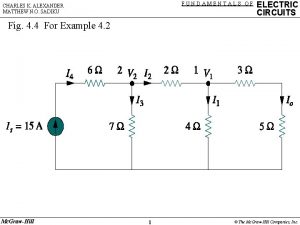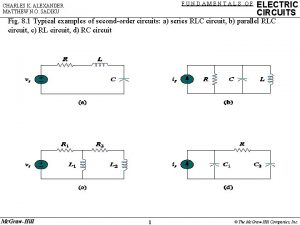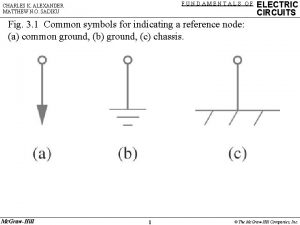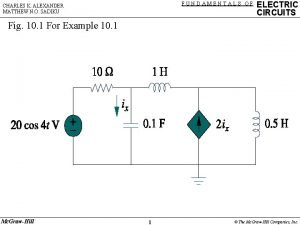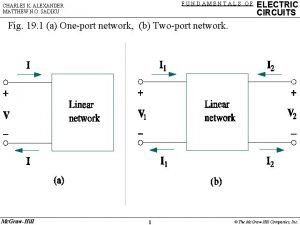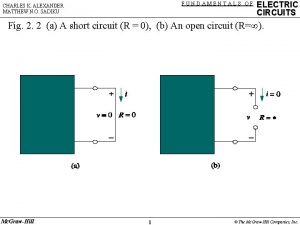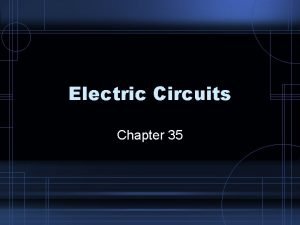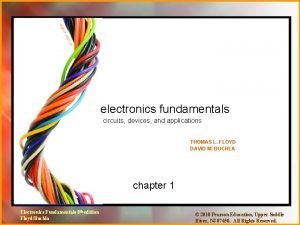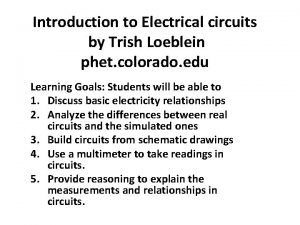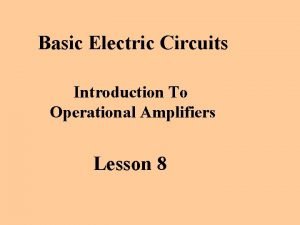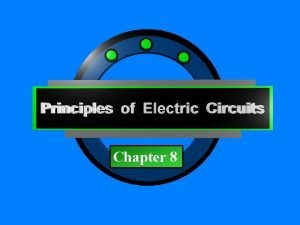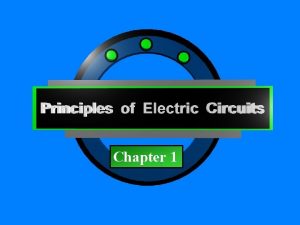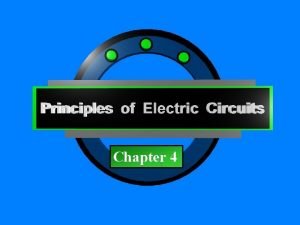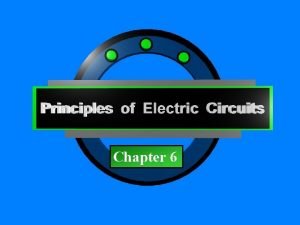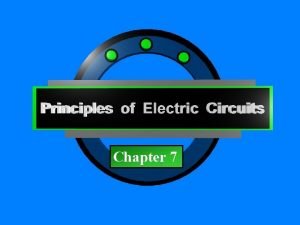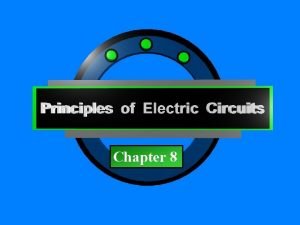Chapter 12 Electric Circuits Fundamentals Floyd Copyright 2007






























- Slides: 30

Chapter 12 Electric Circuits Fundamentals - Floyd © Copyright 2007 Prentice-Hall

Chapter 12 Summary Sinusoidal response of RL circuits When both resistance and inductance are in a series circuit, the phase angle between the applied voltage and total current is between 0 and 90 , depending on the values of resistance and reactance. Electric Circuits Fundamentals - Floyd © Copyright 2007 Prentice-Hall

Chapter 12 Summary Impedance of series RL circuits In a series RL circuit, the total impedance is the phasor sum of R and XL. R is plotted along the positive x-axis. XL is plotted along the positive y-axis. Z Z is the diagonal Z XL XL R R It is convenient to reposition the phasors into the impedance triangle. Electric Circuits Fundamentals - Floyd © Copyright 2007 Prentice-Hall

Chapter 12 Summary Impedance of series RL circuits Sketch the impedance triangle and show the values for R = 1. 2 k. W and XL = 960 W. Z = 1. 33 k. W 39 o XL = 960 W R = 1. 2 k. W Electric Circuits Fundamentals - Floyd © Copyright 2007 Prentice-Hall

Chapter 12 Summary Analysis of series RL circuits Ohm’s law is applied to series RL circuits using quantities of Z, V, and I. Because I is the same everywhere in a series circuit, you can obtain the voltage phasors by simply multiplying the impedance phasors by the current. Electric Circuits Fundamentals - Floyd © Copyright 2007 Prentice-Hall

Chapter 12 Summary Analysis of series RL circuits Assume the current in the previous example is 10 m. Arms. Sketch the voltage phasors. The impedance triangle from the previous example is shown for reference. The voltage phasors can be found from Ohm’s law. Multiply each impedance phasor by 10 m. A. Z = 1. 33 k. W 39 o R = 1. 2 k. W Electric Circuits Fundamentals - Floyd x 10 m. A = XL = 960 W VS = 13. 3 V 39 o VL = 9. 6 V VR = 12 V © Copyright 2007 Prentice-Hall

Chapter 12 Summary Variation of phase angle with frequency Phasor diagrams that have reactance phasors can only be drawn for a single frequency because X is a function of frequency. As frequency changes, the impedance triangle for an RL circuit changes as illustrated here because XL increases with increasing f. This determines the frequency response of RL circuits. Electric Circuits Fundamentals - Floyd © Copyright 2007 Prentice-Hall

Chapter 12 Summary Phase shift For a given frequency, a series RL circuit can be used to produce a phase lead by a specific amount between an input voltage and an output by taking the output across the inductor. This circuit is also a basic high-pass filter, a circuit that passes high frequencies and rejects all others. R Vin L Vout Vin VR Electric Circuits Fundamentals - Floyd © Copyright 2007 Prentice-Hall

Chapter 12 Summary Phase shift Reversing the components in the previous circuit produces a circuit that is a basic lag network. This circuit is also a basic low-pass filter, a circuit that passes low frequencies and rejects all others. L Vin VL R Vin Vout Electric Circuits Fundamentals - Floyd © Copyright 2007 Prentice-Hall

Chapter 12 Summary Sinusoidal response of parallel RL circuits For parallel circuits, it is useful to review conductance, susceptance and admittance, introduced in Chapter 10. Conductance is the reciprocal of resistance. Inductive susceptance is the reciprocal of inductive reactance. Admittance is the reciprocal of impedance. Electric Circuits Fundamentals - Floyd © Copyright 2007 Prentice-Hall

Chapter 12 Summary Sinusoidal response of parallel RL circuits In a parallel RL circuit, the admittance phasor is the sum of the conductance and inductive susceptance phasors. The magnitude of the susceptance is The magnitude of the phase angle is G VS G BL BL Electric Circuits Fundamentals - Floyd Y © Copyright 2007 Prentice-Hall

Chapter 12 Summary Sinusoidal response of parallel RL circuits Some important points to notice are: G is plotted along the positive x-axis. BL is plotted along the negative y-axis. Y is the diagonal G VS G BL BL Electric Circuits Fundamentals - Floyd Y © Copyright 2007 Prentice-Hall

Chapter 12 Summary Sinusoidal response of parallel RL circuits Draw the admittance phasor diagram for the circuit. The magnitude of the conductance and susceptance are: G = 1. 0 m. S VS f = 10 k. Hz R 1. 0 k. W Electric Circuits Fundamentals - Floyd L 25. 3 m. H BL = 0. 629 m. S Y= 1. 18 m. S © Copyright 2007 Prentice-Hall

Chapter 12 Summary Analysis of parallel RL circuits Ohm’s law is applied to parallel RL circuits using quantities of Y, V, and I. Because V is the same across all components in a parallel circuit, you can obtain the current in a given component by simply multiplying the admittance of the component by the voltage as illustrated in the following example. Electric Circuits Fundamentals - Floyd © Copyright 2007 Prentice-Hall

Chapter 12 Summary Analysis of parallel RL circuits Assume the voltage in the previous example is 10 V. Sketch the current phasors. The admittance diagram from the previous example is shown for reference. The current phasors can be found from Ohm’s law. Multiply each admittance phasor by 10 V. G = 1. 0 m. S BL = 0. 629 m. S Y= 1. 18 m. S Electric Circuits Fundamentals - Floyd x 10 V = IL = 6. 29 m. A IR = 10 m. A IS = 11. 8 m. A © Copyright 2007 Prentice-Hall

Chapter 12 Summary Phase angle of parallel RL circuits Notice that the formula for inductive susceptance is the reciprocal of inductive reactance. Thus BL and IL are inversely proportional to f: As frequency increases, BL and IL decrease, so the angle between IR and IS must decrease as well. q IL Electric Circuits Fundamentals - Floyd IR IS © Copyright 2007 Prentice-Hall

Chapter 12 Summary The power triangle Recall that in a series RC or RL circuit, you could multiply the impedance phasors by the current to obtain the voltage phasors. The earlier example from this chapter is shown for review: Z = 1. 33 k. W 39 o R = 1. 2 k. W Electric Circuits Fundamentals - Floyd x 10 m. A = XL = 960 W VS = 13. 3 V 39 o VL = 9. 6 V VR = 12 V © Copyright 2007 Prentice-Hall

Chapter 12 Summary The power triangle Multiplying the voltage phasors by Irms gives the power triangle (equivalent to multiplying the impedance phasors by I 2). Apparent power is the product of the magnitude of the current and magnitude of the voltage and is plotted along the hypotenuse of the power triangle. The rms current in the earlier example was 10 m. A. Show the power triangle. x 10 m. A = VS = 13. 3 V 39 o VL = 9. 6 V VR = 12 V Electric Circuits Fundamentals - Floyd Pa = 133 m. VA Pr = 96 m. VAR 39 o Ptrue = 120 m. W © Copyright 2007 Prentice-Hall

Chapter 12 Inductive susceptance (BL) Key Terms The ability of an inductor to permit current; the reciprocal of inductive reactance. The unit is the siemens (S). Electric Circuits Fundamentals - Floyd © Copyright 2007 Prentice-Hall

Chapter 12 Quiz 1. If the frequency is increased in a series RL circuit, the phase angle will a. increase b. decrease c. be unchanged Electric Circuits Fundamentals - Floyd © Copyright 2007 Prentice-Hall

Chapter 12 Quiz 2. If you multiply each of the impedance phasors in a series RL circuit by the current, the result is the a. voltage phasors b. power phasors c. admittance phasors d. none of the above Electric Circuits Fundamentals - Floyd © Copyright 2007 Prentice-Hall

Chapter 12 Quiz 3. For the circuit shown, the output voltage a. is in phase with the input voltage b. leads the input voltage c. lags the input voltage Vin Vout d. none of the above Electric Circuits Fundamentals - Floyd © Copyright 2007 Prentice-Hall

Chapter 12 Quiz 4. In a series RL circuit, the phase angle can be found from the equation a. b. c. both of the above are correct d. none of the above is correct Electric Circuits Fundamentals - Floyd © Copyright 2007 Prentice-Hall

Chapter 12 Quiz 5. In a series RL circuit, if the inductive reactance is equal to the resistance, the source current will lag the source voltage by a. 0 o b. 30 o c. 45 o d. 90 o Electric Circuits Fundamentals - Floyd © Copyright 2007 Prentice-Hall

Chapter 12 Quiz 6. Susceptance is the reciprocal of a. resistance b. reactance c. admittance d. impedance Electric Circuits Fundamentals - Floyd © Copyright 2007 Prentice-Hall

Chapter 12 Quiz 7. In a parallel RL circuit, the magnitude of the admittance can be expressed as a. b. c. Y = G + BL d. Electric Circuits Fundamentals - Floyd © Copyright 2007 Prentice-Hall

Chapter 12 Quiz 8. If you increase the frequency in a parallel RL circuit, a. the total admittance will increase b. the total current will increase c. both a and b d. none of the above Electric Circuits Fundamentals - Floyd © Copyright 2007 Prentice-Hall

Chapter 12 Quiz 9. The unit used for measuring true power is the a. volt-ampere b. watt c. volt-ampere-reactive (VAR) d. kilowatt-hour Electric Circuits Fundamentals - Floyd © Copyright 2007 Prentice-Hall

Chapter 12 Quiz 10. A power factor of zero implies that the a. circuit is entirely reactive b. reactive and true power are equal c. circuit is entirely resistive d. maximum power is delivered to the load Electric Circuits Fundamentals - Floyd © Copyright 2007 Prentice-Hall

Chapter 12 Quiz Answers: 1. a 6. b 2. a 7. d 3. c 8. d 4. a 9. b 5. c 10. a Electric Circuits Fundamentals - Floyd © Copyright 2007 Prentice-Hall
 Electric circuits fundamentals floyd
Electric circuits fundamentals floyd Fundamentals of electric circuits chapter 4 solutions
Fundamentals of electric circuits chapter 4 solutions 9
9 Fundamentals of electric circuits chapter 7 solutions
Fundamentals of electric circuits chapter 7 solutions Charles k. alexander matthew n. o. sadiku
Charles k. alexander matthew n. o. sadiku Fundamentals of electric circuits
Fundamentals of electric circuits Alexander
Alexander Sadiku
Sadiku Alexander
Alexander Alexander sadiku
Alexander sadiku Ise fundamentals of electric circuits
Ise fundamentals of electric circuits Floyd digital fundamentals 10th edition pdf
Floyd digital fundamentals 10th edition pdf Digital fundamentals by floyd 10th edition
Digital fundamentals by floyd 10th edition Digital fundamentals floyd 10th edition
Digital fundamentals floyd 10th edition Chapter 20 electric circuits
Chapter 20 electric circuits Conceptual physics chapter 35
Conceptual physics chapter 35 Chapter 20 electric circuits
Chapter 20 electric circuits Chapter 35 electric circuits answers
Chapter 35 electric circuits answers Chapter 35 electric circuits answers
Chapter 35 electric circuits answers Chapter 35 electric circuits
Chapter 35 electric circuits Current in a parallel circuit
Current in a parallel circuit Electronics fundamentals circuits devices and applications
Electronics fundamentals circuits devices and applications Chapter 21 electric charge and electric field
Chapter 21 electric charge and electric field Chapter 21 electric charge and electric field
Chapter 21 electric charge and electric field Chapter 16 electric charge and electric field
Chapter 16 electric charge and electric field Chapter 21 electric charge and electric field
Chapter 21 electric charge and electric field Copyright 2007
Copyright 2007 Pearson
Pearson Phet circuit
Phet circuit Electric circuits equations
Electric circuits equations Electric circuits nilsson
Electric circuits nilsson




